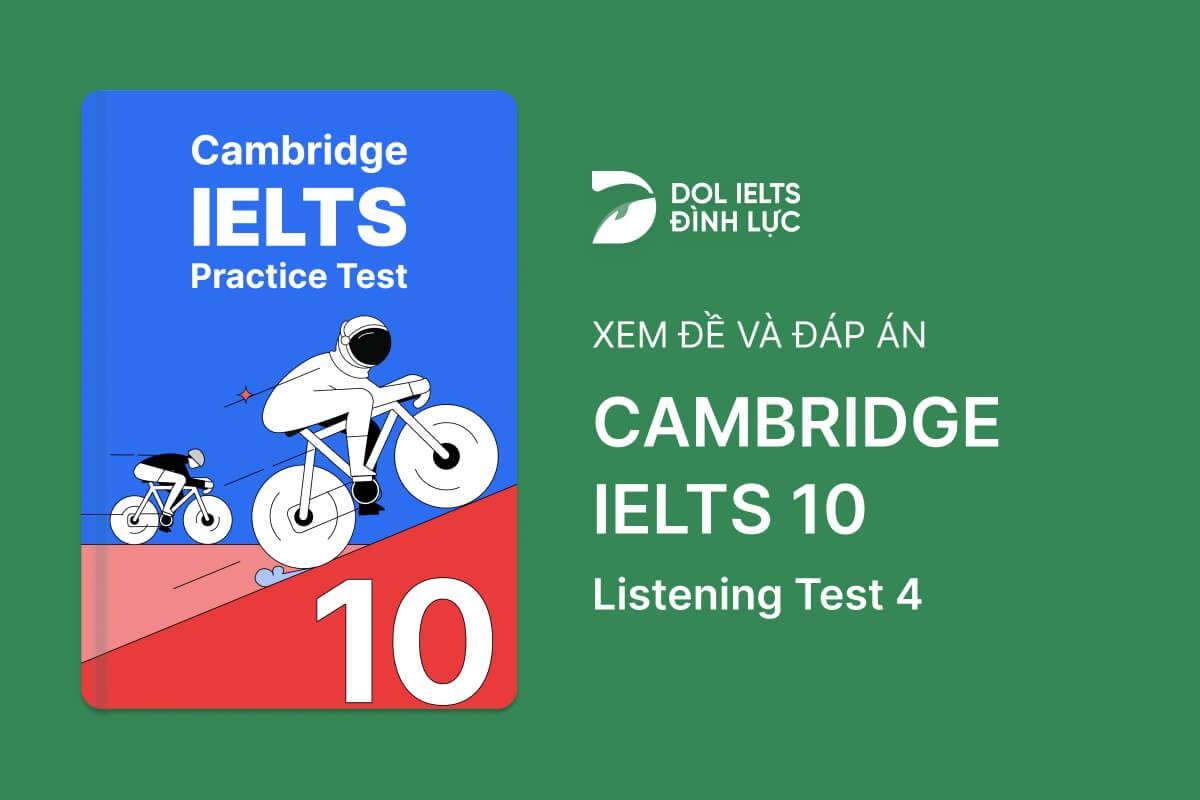Cambridge IELTS 10 - Listening Test 4 With Practice Test, Answers And Explanation
Luyện tập đề IELTS Online Test Cambridge IELTS 10 - Listening Test 4 được lấy từ cuốn sách Cambridge IELTS 10 với trải nghiệm thi IELTS trên máy và giải thích đáp án chi tiết bằng Linearthinking, kèm answer key và list từ vựng IELTS cần học trong bài đọc.
Section
👂️ Bài nghe section 1
Example
❓ Tapescript section 1
🔥 Đáp án & giải thích section 1
Giải thích chi tiết
 Xác định từ cần điền là noun chỉ họ của Edith
Xác định từ cần điền là noun chỉ họ của Edith
 Khi bạn nghe "And what’s your name, please?" là biết đáp án chuẩn bị vào.
Khi bạn nghe "And what’s your name, please?" là biết đáp án chuẩn bị vào.
 Sau đó, vị khách trả lời " It’s Edith Pargetter".
Sau đó, vị khách trả lời " It’s Edith Pargetter".
>> Đến đây chưa biết cách viết sao cho đúng chính tả thì hãy nhớ là sẽ luôn có phần spelling nha "It’s P-A-R-G-E-double T-E-R"
>> Từ cần điền là "Pargetter" 
Section
👂️ Bài nghe section 2
❓ Tapescript section 2
🔥 Đáp án & giải thích section 2
Giải thích chi tiết
 Sau khi nghe đến "The port of Manham" là bạn biết đáp án chuẩn bị vào.
Sau khi nghe đến "The port of Manham" là bạn biết đáp án chuẩn bị vào.
 Sau đó nghe "and developed here because it’s the highest navigable point of the Avon – boats can go no higher up this river – and proved a handy place to load and unload cargo to and from the sea, which is over 23 miles away."
Sau đó nghe "and developed here because it’s the highest navigable point of the Avon – boats can go no higher up this river – and proved a handy place to load and unload cargo to and from the sea, which is over 23 miles away."
>> Và nó được phát triển ở đây vì nó là điểm điều hướng cao nhất của Avon - thuyền có thể đi không cao lên con sông này - và chứng tỏ là một nơi thuận tiện để tải hàng hóa
>> Vì đây là nơi điều hướng và thuận tiện vận tải hàng hóa nên sẽ là nơi thuận tiện cho vận tải trên biển
>> Chọn B 
Section
👂️ Bài nghe section 3
❓ Tapescript section 3
🔥 Đáp án & giải thích section 3
Giải thích chi tiết
 Sau khi nghe "What kind of skills do you think you developed on the placement?" là biết đáp án chuẩn bị vào.
Sau khi nghe "What kind of skills do you think you developed on the placement?" là biết đáp án chuẩn bị vào.
 Nhiều bạn sau khi nghe thấy "I did have to use my IT skills to a certain extent because I cut and pasted text from marketing leaflets" thì chọn câu trả lời là C
Nhiều bạn sau khi nghe thấy "I did have to use my IT skills to a certain extent because I cut and pasted text from marketing leaflets" thì chọn câu trả lời là C
>> Nhưng mà sau đó Laura đã nói rằng những việc này cô đều đã làm hết rồi, câu này cho thấy đây không phải là một kỹ năng mà cô ấy muốn "improve".
>> Loại C
 Sau đó nghe "Do you think you got any better at managing your time and prioritising things? You always used to say you had trouble with that…"
Sau đó nghe "Do you think you got any better at managing your time and prioritising things? You always used to say you had trouble with that…"
Section
👂️ Bài nghe section 4
Nanotechnology could allow the development of stronger
34
Planes would be much lighter in weight.
travel will be made available to the masses.35
Computers will be even smaller, faster, and will have a greater
36
energy will become more affordable.37
Nano-robots could rebuild the ozone layer.
Pollutants such as
could be removed from water more easily.38
There will be no
from manufacturing.39
New methods of food production could eradicate famine.
Analysis of medical
will be speeded up.40
Life expectancy could be increased.
❓ Tapescript section 4
🔥 Đáp án & giải thích section 4
Giải thích chi tiết
 Khi bạn nghe thấy "However, all new technologies have their teething problems" là biết đáp án chuẩn bị vào.
Khi bạn nghe thấy "However, all new technologies have their teething problems" là biết đáp án chuẩn bị vào.
 Sau đó bạn nghe "with nanotechnology, society often gets the wrong idea about its capabilities"
Sau đó bạn nghe "with nanotechnology, society often gets the wrong idea about its capabilities"
>> Với công nghệ nano, xã hội thường hiểu sai về khả năng của nó
>> Chọn C 


